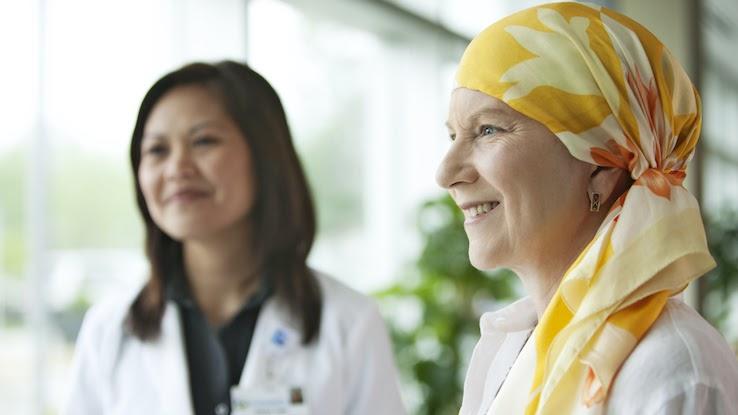Confusian What Worked Once Will Work Again

Cancer develops due to the uncontrollable growth of harmful cells or a tumor in the trunk. Types of cancer can differ based on the region where they grow in a person'southward body or the blazon of bodily systems that are affected by that growth. Many people who are diagnosed with cancer are advised to undergo chemotherapy to treat the disease.
Approximately 650,000 patients with cancer receive outpatient chemotherapy in the U.Due south. each year. This type of treatment can exist very effective in eliminating or stopping the spread of cancer, but it does have some risks to consider every bit well. Larn the basics about chemotherapy, including how it works, what to look when undergoing treatment and the potential side effects to consider.
What Is Chemotherapy?
Chemotherapy, often referred to just every bit "chemo," is the use of specific types of medication to treat cancer. There are more than 100 chemotherapy drugs available that tin can be used individually or in dissimilar combinations to treat various types of cancer. These medications are adult to specifically target cells that are rapidly dividing and multiplying; some medications alter the harmful cancer cells' DNA, while others rely on blocking the chemic signaling that controls prison cell division. Depending on the specific mechanism of activeness, these drugs work by stopping or slowing the growth of cancer cells or past really destroying the dividing cells.
Chemotherapy is different from radiation therapy and surgery in that chemotherapy affects a person's unabridged torso, while radiations and surgery affect only the expanse of the body where the cancer is located. In many cases, chemotherapy is combined with surgery or radiation therapy to care for cancer. Chemotherapy tin can also treat bone marrow diseases and immune organization disorders.
Following a cancer diagnosis, chemotherapy tin can be used for several purposes:
- Treating cancer: Sometimes chemo can destroy cancer cells to the signal that cancer tin no longer be detected in a patient's body. In many cases, the cancer cells won't grow back once the handling has reached this point.
- Controlling cancer: Chemo tin besides be utilized to end or slow the spread of cancer to other parts of the body or kill cancer cells that have already spread.
- Easing cancer symptoms: Chemo can shrink tumors that are causing pain or pressure. This is as well known as palliative care.
What to Await When Undergoing Chemotherapy
The specifics of your chemotherapy treatment volition depend on the healthcare professional yous're working with, the type and severity of the cancer yous have and the types of medications your health insurance covers, among other factors. You lot may receive your treatment at home, in a dispensary, in a infirmary or in a healthcare professional's function. While some patients receive treatments daily, others just need them weekly or monthly. However, nearly professionals arrange for their patients to receive handling in cycles to let for periods when their bodies take time to rebuild healthy cells.
There are several ways doctors can administrate chemotherapy drugs. Inquire about these dissimilar options if you have concerns about how you'll receive your treatments:
- Oral: You may take the medications by oral cavity in pill, capsule or liquid form.
- Topical: The drug is administered on your pare as a cream, gel or ointment.
- Continuous infusions: This procedure involves the apply of an electronic IV pump that administers the drugs over a menstruation of ane to 7 days.
- Injections: The drugs may be injected into certain areas (the spinal culvert, a muscle, an artery, etc.) to care for a more specific area of your body.
- Catheter: This involves inserting a catheter into your forearm or hand, and the chemotherapy drugs are injected into the catheter through a syringe. The catheter can be placed each fourth dimension a treatment takes place. However, yous might also have a primal venous catheter temporarily placed in your chest or upper arm for easy access at each treatment. This procedure can take just a few minutes.
- IV infusion: This is like to a catheter except that the drugs are mixed into a solution and administered through tubing attached to the catheter. This takes between 30 minutes and a few hours to consummate.
Potential Side Furnishings of Chemotherapy
Many of the side effects chemotherapy causes are a result of the drugs affecting your unabridged trunk (including healthy cells) in add-on to the areas the cancer is affecting. Some vulnerable areas that are often affected by chemotherapy include the oral fissure, intestines, cells responsible for pilus growth and bone marrow.
The following are some potential side effects of chemotherapy:
- Loss of appetite
- Nausea or vomiting
- Piece of cake bruising
- Fatigue
- Pilus loss
- Anemia
- Fever
- Mouth sores
- Hurting
- Diarrhea or constipation
Your healthcare provider can help y'all observe ways to manage or alleviate these side effects if you feel them. For example, certain dietary changes can help with diarrhea, and many people choose to buy wigs and scarves to cover their heads afterward experiencing hair loss.
Possible Health Risks of Chemotherapy
In add-on to the side furnishings that may arise because of chemotherapy treatments, in that location are besides a few possible long-term health risks that may appear during or after completion of your handling. These risks include:
- Weakened amnesty and increased adventure of infection
- Infertility
- Heart problems
- Kidney problems
- Nerve damage
- Damage to lung tissue
- Risk of getting some other type of cancer
Chemotherapy does come up with risks, but it has also saved thousands of lives. Information technology'southward important to consult with your healthcare provider about the pros and cons of chemo treatment, learn how the drugs will exist administered and ask about ways to manage possible side furnishings.
Resource Links:
https://www.cancer.gov/well-nigh-cancer/treatment/types/chemotherapy
https://www.cancer.org/treatment/treatments-and-side-effects/treatment-types/chemotherapy.html
https://medlineplus.gov/cancerchemotherapy.html
https://www.mayoclinic.org/tests-procedures/chemotherapy/about/pac-20385033
https://www.cdc.gov/cancer/preventinfections/patients.htm
tenchnotiontery45.blogspot.com
Source: https://www.symptomfind.com/health/chemotherapy?utm_content=params%3Ao%3D740013%26ad%3DdirN%26qo%3DserpIndex